I have long promised a post on aloes. Well, today I trawled through the last 5 years’ photos and I can promise you: there will be several posts to follow! I will start by concentrating on our local giant as it grows in the wild.
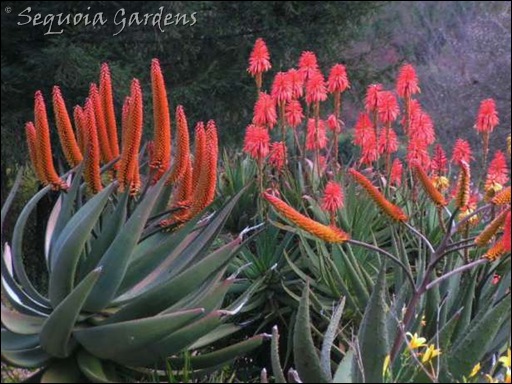 This is not that. Rather it is a photo from 2005 – the best year ever – of the aloes in our garden. Three types, about which more later. What is important is that the slightly more orange one in the foreground, with the candelabra of flowers carried almost horizontally, is Aloe marlothii. Looking great, for once… (No. Don’t harp on it that this is not really aloe country.) In the photo below it grows just 15km away, in one of the proudest stands of aloes you can find anywhere in the world!
This is not that. Rather it is a photo from 2005 – the best year ever – of the aloes in our garden. Three types, about which more later. What is important is that the slightly more orange one in the foreground, with the candelabra of flowers carried almost horizontally, is Aloe marlothii. Looking great, for once… (No. Don’t harp on it that this is not really aloe country.) In the photo below it grows just 15km away, in one of the proudest stands of aloes you can find anywhere in the world!
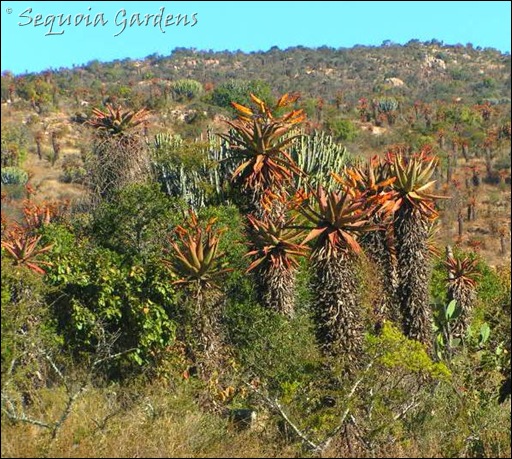 I remember travelling through here on the way to the farm from Johannesburg in the early 60s and being told: your grandmother says they look like the Zulu impis (army) coming over the hill. (Need I add that she was a poet, and left a long line of dreamers and romantics?) When happy they grow over many many years to over 6m in height. Generations of fleshy leaves hang shrivelled, intensely colourless but still painfully thorny from their trunks. All year they are crowned with a starburst of leaves; the more stressed they are, the more colourful the leaves. And here lies their true glory. The flowers are a bonus, God’s largesse. The leaves are green. In places. They are also glaucous and russet and ochre and other colours much loved by stylists. And every winter a shock of burnt orange flowers against the blue.
I remember travelling through here on the way to the farm from Johannesburg in the early 60s and being told: your grandmother says they look like the Zulu impis (army) coming over the hill. (Need I add that she was a poet, and left a long line of dreamers and romantics?) When happy they grow over many many years to over 6m in height. Generations of fleshy leaves hang shrivelled, intensely colourless but still painfully thorny from their trunks. All year they are crowned with a starburst of leaves; the more stressed they are, the more colourful the leaves. And here lies their true glory. The flowers are a bonus, God’s largesse. The leaves are green. In places. They are also glaucous and russet and ochre and other colours much loved by stylists. And every winter a shock of burnt orange flowers against the blue.
Here it is again, photographed near the Tropic of Capricorn earlier this year. Bringing colour to a bone-dry veldt, surrounded by trees a European would believe dead and backed by what passes for an Euphorbia in Africa. Yes, it is a tree. A rather large, solid tree, a cactus tree. But more of that later.
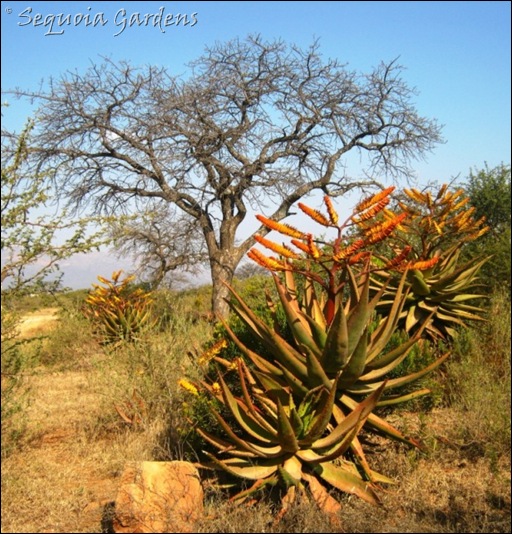 And again, near a school where our Rotary Club is heavily involved, some 45km from Sequoia. In the background a Marula tree in its gaunt winter garb –Sclerocarya birrea. You might have seen footage of animals drunk from its fermenting fruit which covers the ground in autumn. The fruit pulp contains four times more Vit. C than oranges. The nuts are a great African delicacy. When you fly out of South Africa you will buy Amarula Cream, possibly our most popular liqueur. And the Tonga people from close by will “celebrate the Feast of the First Fruits by pouring a libation of the fresh juice over the tombs of their dead chiefs”*
And again, near a school where our Rotary Club is heavily involved, some 45km from Sequoia. In the background a Marula tree in its gaunt winter garb –Sclerocarya birrea. You might have seen footage of animals drunk from its fermenting fruit which covers the ground in autumn. The fruit pulp contains four times more Vit. C than oranges. The nuts are a great African delicacy. When you fly out of South Africa you will buy Amarula Cream, possibly our most popular liqueur. And the Tonga people from close by will “celebrate the Feast of the First Fruits by pouring a libation of the fresh juice over the tombs of their dead chiefs”*
* Keath Coates Palgrave – Trees of Southern Africa, p458
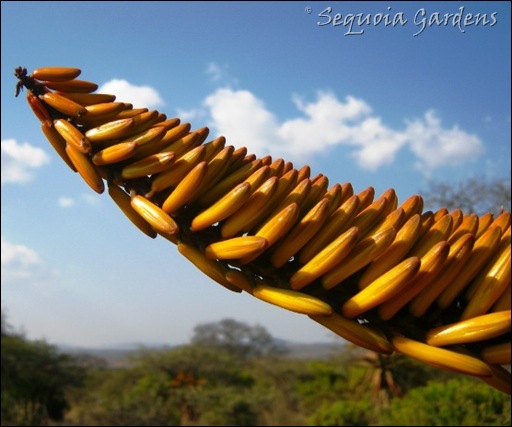 This particular example had unusually yellow flowers. Behind it and beyond two more Marula trees, and if you use your imagination, rolling ground further away leads to the mountains where you will find Sequoia Gardens.
This particular example had unusually yellow flowers. Behind it and beyond two more Marula trees, and if you use your imagination, rolling ground further away leads to the mountains where you will find Sequoia Gardens.
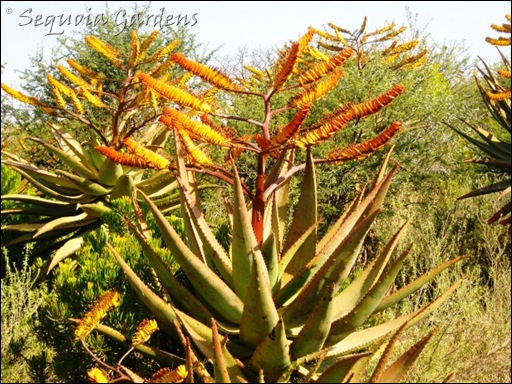 Lastly, because I can not bear not to include them, more examples from a few hundred meters further down the road !
Lastly, because I can not bear not to include them, more examples from a few hundred meters further down the road !
Now go back to that first photo. Do you see what I mean…

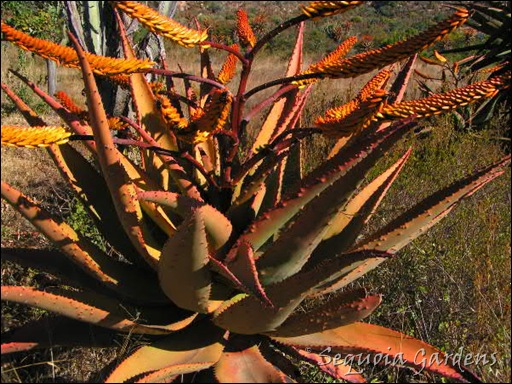
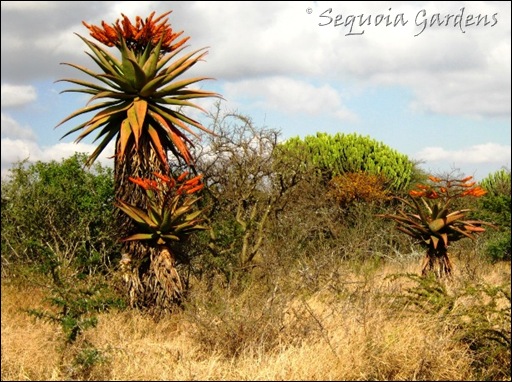
These are stunning. And thanks for the pics of the wild stands. Fascinating. Love the zulu impis!
Thanks, Susan. I’ll be back with more – although these pics, truth be told, are my faves amongst some sixty. Marlothii is simply the king of aloes! Although, thinking chess, there is very much a queen. Hmmm. And a castle. Perhaps I should explore this association…
As always, lovely photos! I haven’t visited for a while, and will have to spend some time catching up on those posts I’ve missed…
I have to agree that marlothii has to be the king…maybe thraskii would be queen? But then what about barbarae? Could be a tricky chess set?
Its amazing to see the vegetation growing just 15km away from you looks so radically different from your garden on the farm.
Hi Ross and welcome! A. ferox is my Queen! (Her red in an Eastern Cape or Natal winter is regal!) Having just been on google to ID thraskii, which I don’t know by name, it looks as though it might be a slightly heavy-set bishop! And as for Barberae, that has to be the Castle…
As for biome changes – I’m certain there are places in the Natal midlands that swing almost instantly between mist belt and stony African valleys, just like we have here.
What About the aloe dichotoma??????
Pingback: ALOES- OUR ULTIMATE WINTER WILD FLOWER « Sequoia Gardens Blog